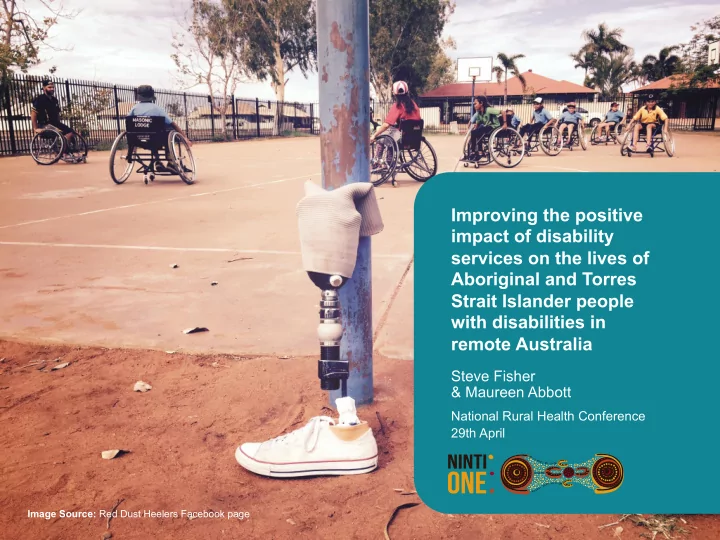

Improving the positive impact of disability services on the lives of Image Source: Red Dust Heelers Facebook page Image Source: Red Dust Heelers Facebook page Aboriginal and Torres Strait Islander people with disabilities in remote Australia Steve Fisher & Maureen Abbott National Rural Health Conference 29th April Image Source: Red Dust Heelers Facebook page
Disability in Aboriginal and Torres Strait Islander communities Aboriginal and Torres Strait Islanders make up 16% of the population in remote areas Image Source: Red Dust Heelers Facebook page Image Source: Red Dust Heelers Facebook page (AATSIHS 2013; AIHW 2015)
Disability in Aboriginal and Torres Strait Islander communities Aboriginal and Torres Strait Islanders make up 16% of the population in remote areas (48% in very remote areas) Image Source: Red Dust Heelers Facebook page Image Source: Red Dust Heelers Facebook page (AATSIHS 2013; AIHW 2015)
Disability in Aboriginal and Torres Strait Islander communities Aboriginal and Torres Strait Islanders make up 16% of the population in remote areas (48% in very remote areas) In 2012, only 13% of Aboriginal people accessing disability services nationally lived in a remote or very remote area Image Source: Red Dust Heelers Facebook page Image Source: Red Dust Heelers Facebook page (AATSIHS 2013; AIHW 2015)
Disability in Aboriginal and Torres Strait Islander communities Aboriginal and Torres Strait Islanders make up 16% of the population in remote areas (48% in very remote areas) In 2012, only 13% of Aboriginal people accessing disability services nationally lived in a remote or very remote area Image Source: Red Dust Heelers Facebook page Image Source: Red Dust Heelers Facebook page 35.7% of ATSI population living with a disability (AATSIHS 2013; AIHW 2015)
Disability in Aboriginal and Torres Strait Islander communities Aboriginal and Torres Strait Islanders make up 16% of the population in remote areas (48% in very remote areas) In 2012, only 13% of Aboriginal people accessing disability services nationally lived in a remote or very remote area Image Source: Red Dust Heelers Facebook page Image Source: Red Dust Heelers Facebook page 35.7% of ATSI population living with a disability and are 1.7 times more likely to live with disability than non-Aboriginal Australians (AATSIHS 2013; AIHW 2015)
Disability-inclusive development Inclusion Image Source: Summer Foundation Image Source: Red Dust Heelers Facebook page Image Source: Red Dust Heelers Facebook page Equality Poverty reduction Integration Participation
NDIS: The missing link Advocacy Active empowerment Image Source: Red Dust Heelers Facebook page Image Source: Red Dust Heelers Facebook page Remote Aboriginal Innovation & quality context requires more concerted effort to achieve. Role of carers
Lessons from Ninti One • Passive response to services • Low knowledge about disability • Uneven standards Image Source: Red Dust Heelers Facebook page Image Source: Red Dust Heelers Facebook page • Cross-cultural capacity under-developed • Lack of local disability advocacy groups • Transactional rather than transformative
Recommendations Research Raise awareness • Alongside Aboriginal people in • Emphasis: role of the wider remote settings community • Determine reach, coverage and • Aim: tackling local obstacles and character of disability and stigma services Image Source: Red Dust Heelers Facebook page Image Source: Red Dust Heelers Facebook page
Recommendations Close the Disability Gap Build knowledge and skills • Introduce new target into COAG’s • Augment National Disability Closing the Gap framework strategy • Aim: to decrease the significantly • Aim: emphasise importance of greater chance of ATSI people to knowledge and inclusion for be living with a disability enabling self-advocacy Image Source: Red Dust Heelers Facebook page Image Source: Red Dust Heelers Facebook page
Recommendations Transformative services Culturally appropriate services • Develop specific plan alongside • Train staff to work more effectively ATSI organisations across cultures • Links education and inclusion to • Aim: increase accessibility of advocacy and empowerment disability services to Aboriginal strategies and Torres Strait Islander people Image Source: Red Dust Heelers Facebook page Image Source: Red Dust Heelers Facebook page
Recommendations Advocacy and empowerment • Build capacity of advocacy networks empowering Aboriginal leaders • Invite advocacy networks to advise and contribute to service improvement Image Source: Red Dust Heelers Facebook page Image Source: Red Dust Heelers Facebook page
Recommend
More recommend